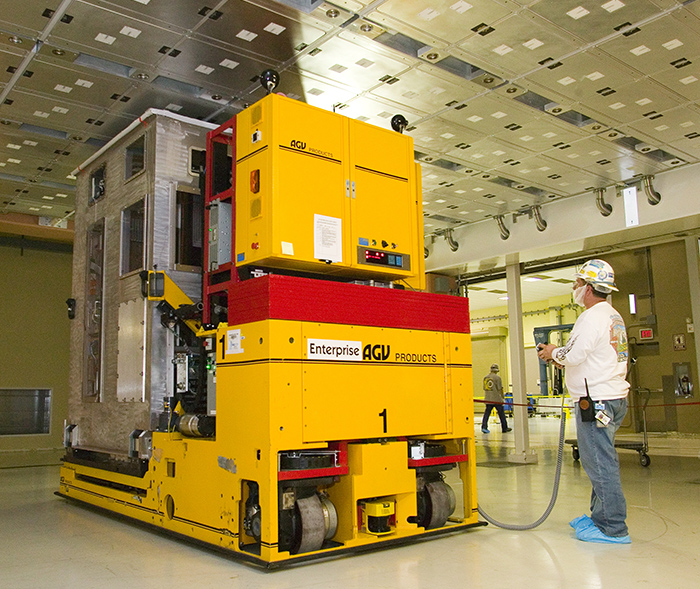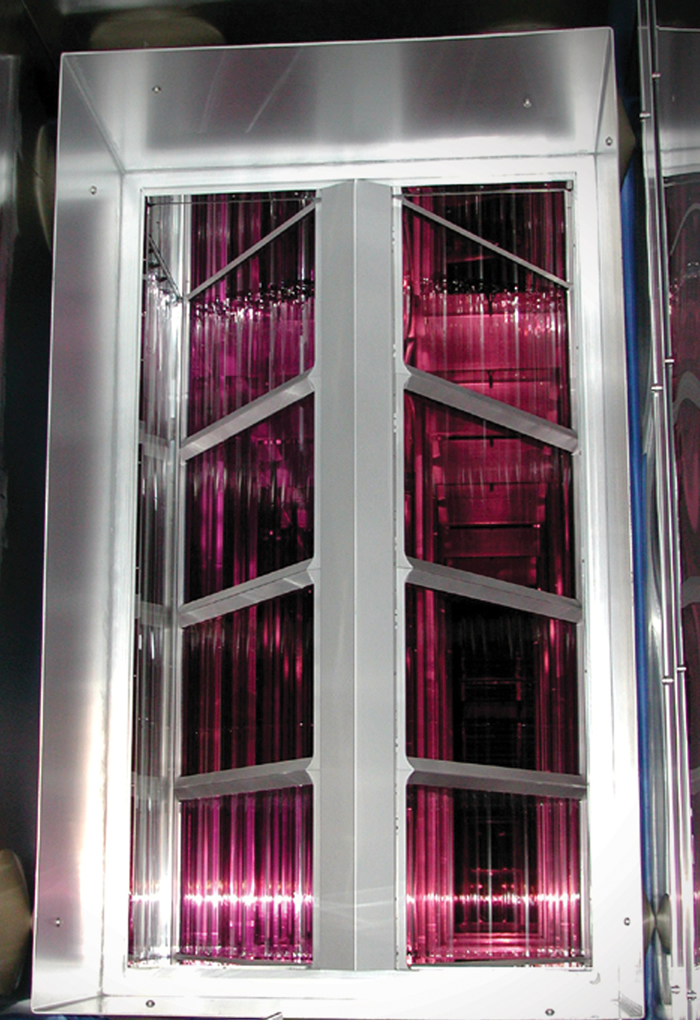Amplifiers

Boosting the Power
From the injection laser system, the laser beams enter the main laser amplifier beamlines in groups of four called quads; two quads make up a bundle, and six bundles constitute a cluster. Four clusters—two in each of the two laser bays—add up to NIF’s total of 192 laser beams. Each beamline contains two large amplifier sections, the main amplifier and the power amplifier. The amplifiers are designed to efficiently provide all of NIF’s power and energy.
The amplifiers vastly augment the weak 1-joule input pulse sent from the injection laser system and determine the beam’s spatial, spectral, and temporal characteristics. When fully integrated with laser amplifier glass, flashlamps, pulsed power, and other related components, the amplifiers are the largest of NIF’s integrated systems, occupying approximately one-fourth of the facility’s floor space.Laser Glass
NIF’s amplifiers use 3,072 42-kilogram neodymium-doped phosphate glass slabs—16 glass slabs per beam. Each measures 3.4 by 46 by 81 centimeters and is set on edge at a specific angle, known as Brewster’s angle, so that the laser beams have very low reflective losses while passing through the glass. The glass slabs are “doped” with neodymium atoms, which impart a pinkish color to the glass.
When the slabs are bathed in the intense white light of the flashlamps that surround them, the neodymium atoms are raised to higher energy states (see How Lasers Work). When a low-energy laser pulse from the injection laser system passes through the slabs, the neodymium atoms release their extra energy into the laser pulse in the form of photons, increasing the pulse’s brightness. The neodymium-doped phosphate laser glass is the result of a six-year joint research and development program with industrial partners SCHOTT North America and Hoya Corp. USA. This effort developed a revolutionary continuous pour process for manufacturing meter-size slabs of laser glass that is 10 times faster, 5 times cheaper, and with better optical quality
Flashlamps
The amplifier slabs are surrounded by vertical arrays of flashlamps. Measuring nearly 180 centimeters (6 feet) tall, NIF’s 7,680 flashlamps are the largest commercial lamps ever made. When driven with about 50,000 joules of electrical energy, the flashlamps emit bright white light that is absorbed by the neodymium in the glass slabs, exciting the atoms to provide optical gain at the 1,053-nanometer (infrared) wavelength, also referred to as 1ω or “1 omega” light. The flashlamps are forced-air cooled between shots to prevent the amplifier slabs from heating up and reduce resulting beam distortions in order to meet the operational requirement of one shot every eight hours.
Automated Guided Vehicles
 The laser bay transporter, an automated guided vehicle, is used to install canisters containing amplifier slab cassettes, known as line replaceable units, into the main amplifier frame assembly units.
The laser bay transporter, an automated guided vehicle, is used to install canisters containing amplifier slab cassettes, known as line replaceable units, into the main amplifier frame assembly units. Assembled and tested amplifier and flashlamp modules are loaded into Class 100 clean-room environment canisters before being transported to the laser bays. The canisters are mounted on special automated guide vehicles and moved to the beampath. The transporters position the canisters, docking them to the amplifier structure to a tolerance of 1 millimeter and one-tenth of a degree rotation. The computer-controlled transporters use wall-mounted fiducials, or reference points, to precisely navigate the facility and negotiate tight corners to their destination with only centimeters of clearance.
Next Up: Beam Transport




